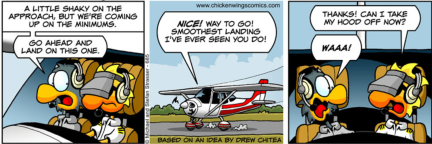Flying is easy! Keep the sky above you and the ground below, point the aircraft in the direction you want to go, look out the window occasionally to know where you are, with towns, lakes roads and so on. Easy, Right?
During the day time with clear blue skies in small aircraft with Visual Flight Rules (VFR), it is at least. What about at night or in the clouds, fog or rain? Or in big heavy aircraft, travelling at 900km/h? How do pilots know where they are going and not crash into each other?
 If that question makes you a little anxious while you fly, don’t worry. You can keep sipping your champagne and relax, knowing that your Pilots have studied and trained hard to know where we are and where we are going, using accurate instruments and systems.
If that question makes you a little anxious while you fly, don’t worry. You can keep sipping your champagne and relax, knowing that your Pilots have studied and trained hard to know where we are and where we are going, using accurate instruments and systems.
For those curious, we do this using Instrument Flight Rules (IFR). A set of rules and navigation systems using; aircraft instrumentation, ground based Navigation beacons and facilities, inertial navigation systems and more recently GPS. Combine with Radar and radio communication procedures with Air Traffic Control, to organise separate and control aircraft. Kind of like an invisible, three dimensional, multi-layer, sky highway. Learning how to fly these “highways” takes a while to master. As always, it starts in the classroom with theory, then simulator or synthetic trainer, a computer simulator where your mistakes don’t kill you. And finally the aircraft, where your mistakes can kill you.


This was my experience
January, the hottest, driest month of the year, and this day was no exception. The air was hot and dry, not a cloud to be seen and I was ready for my first real IFR flight: Mangalore to Shepparton for a few practice approach procedures then back to Mangalore.
I had practised these procedures countless times in the air-conditioned comfort of the Synthetic Trainer and on my computer, using Microsoft Flight Simulator, a very useful study tool, But I was far from mastering them.
We began taxi by mid-morning, much later in the day than I’d like. The summer sun had begun heating the earth, pushing the temperature past 35 Degrees Celsius, on its way to 40. My shirt already damp from perspiration, the first few buttons open, along with the aircraft door, trying to promote any sort of fresh air flow while we taxied.

Things didn’t get much better once we were in flight. The heated earth was sending intense thermals into the sky causing constant turbulence, bouncing our little plane around the sky, requiring constant control input. To make matters worse, I was “under the Hood”. An awkward device that you wear on your head which prevents you from looking out the window, forcing you to use only instruments to fly and navigate.

With frustration and difficulty, I focused on the bouncing instruments, gripping the controls with my sweaty hands. I needed a third hand and a second brain to manage the workload. But all I had was an instructor beside me watching and critiquing, “Altitude, Heading, Tracking, Altitude”
I couldn’t wait to get back on the ground. I persevered, trying not to let the rough conditions frustrate me, taking the sortie one step at a time. The two-hour flight left me physically and mentally exhausted. And I didn’t even see a cloud.

My first moment flying in clouds, real IMC (instrument conditions), is still very memorable. I remember it so well because it’s burnt deep into my memory, along with a good human factors lesson. Because in that moment I realised how quickly I could kill myself.
My instructor and I were heading towards Melbourne at 6000feet, on my first IFR navigation flight at night. Fortunately, as it was a cool summer night, the air was as smooth as silk.
With my attention focused carefully on the instrument panel of the ‘Autopilot-less’ aircraft, my instructor asks; “Have you flown in cloud yet?” “No, not yet” I reply. “Well, you’re about to,” he says, switching the landing lights on. I lift my eyes, fixating on the illuminated oncoming clouds. There’s something captivating about this moment, as we are swallowed by misty cloudiness for my first time.
Seconds later I break my fixation and I re-focus on the instruments, finding the aircraft banked 30degress to the left, pitch 5 degrees down, altitude 250 feet low and quickly descending. I yank the controls correcting the attitude and my flight path. The deviation was so gentle I hadn’t even felt it; I was seconds away from a spiral dive and had no clue. I’ve read stories of pilots dying like that!
Now I had a new problem. The aggressive correction as confused my inner ear. It now feels like we are banked 30 degrees right, but my instruments are saying we are straight and level. This spatial disorientation is known as Sensory Illusion or The Leans. Our caveman vestibular system isn’t designed for flight; it can be a dangerous situation for an inexperienced pilot, with the potential of a Graveyard Spiral. This is my first real experience of this illusion. I’ve heard “Trust Your Instruments!” so many times in training that it’s ringing in my head automatically. So do, I trust my instruments and tilt my head to the left to help my ear feel more normal, a tip I had read about in an old theory book.
A long 30 seconds later, I regain my senses. The instructor quietly monitoring me gave me more confidence. I am still not sure if he, himself a young pilot at only 21years old, was expecting that situation to occur. But it was a valuable lesson.
A week later, Victoria was hit with devastating Bushfires; Black Saturday. 50 Kilometres away, fires raged out of control for weeks, blanketing the state in smoke. When the smoke was thin enough to allow us to take off and land, we were able to fly. The smoke giving an eerie unpredictable environmental condition to fly in. The positive being, it was real instrument conditions and it was better than being under the damn hood
With my training coming to an end and a successful flight test. I took my first flight as an IFR rated pilot. I couldn’t wait to exercise my new licence and fly anywhere without being bound by cloud or rain.

It was a beautiful day heading into Canberra, I was eagerly expecting vectors onto an ILS (instrument approach). Then to my surprise and disappointment, I hear “X-ray Delta India, You’re cleared for a visual Approach runway 35.” What the hell? I was IFR! – I hadn’t realised this obvious point since we never practised it in IFR training: You can still do a visual approach (a simple VFR procedure) when you’re IFR, as long as you’re in visual conditions (VMC).
After the “WTF?!” moment followed by the “Well Duh” moment, I looked out the window, pointed the aircraft towards the airport and landed. Easy!
Tip for the young aviator.
Throughout my career, I have supplemented my flight training with hours and hours of playing Microsoft flight simulator (FSX), even during my training for the 777.
Obviously, you can’t log any of it. But it is a great and affordable training tool. Especially with real flight time or full motion flight simulator time starting around $300 per hour and going into the thousands of dollars per hour. Flight Sim is free after the small purchase cost. You can practice anything from circuits and radio calls to Instrument approaches and procedures, failures, Scan-flows even rehearsing full flights. It gives you a real time learning scenario, with time pressure to force errors and highlight weaknesses and deficiencies which you can learn from.


I highly recommend it if you are studying to be a pilot. Plus, it gives you a break from the books. Just don’t get too distracted trying to get a good score flying the Redbull Air Race.

I highly recommend PMDG, Virtual Avionics and Aerosoft. I used the PMDG Boeing 777 as a training aid and have played with the Aerosoft A320. All buttons and switches function as they do in the real aircraft.
I will use their products again for any other future aircraft I get to fly. Just make sure your computer is powerful enough to run the programs.
https://www.precisionmanuals.com/
http://www.aerosoft.com


